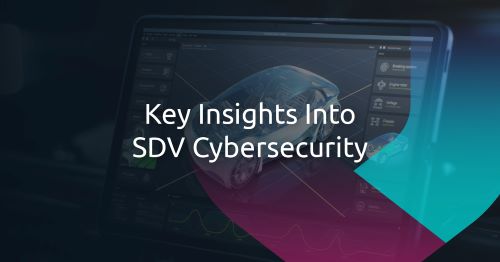
Software-defined vehicles (SDVs) mark a transformative leap in the automotive industry, offering a more intelligent, connected, and adaptable mobility experience. However, as innovation evolves, so do cybersecurity risks. To unlock the full potential of SDVs while ensuring safety, security, and privacy, the automotive industry must confront these challenges head-on.
In this blog post, we explore the key vulnerabilities within the SDV ecosystem and discuss strategies for securing SDVs. For a deeper dive into these issues, our report “The State of SDV Cybersecurity: Navigating Innovation and Risk” provides comprehensive insights into the challenges, threats, and solutions shaping the future of SDVs.
Software challenges
SDVs rely on advanced software, over-the-air (OTA) updates, and cloud-based systems — creating a broad attack surface. Threats range from vehicle hijacking to data breaches and ransomware attacks. Vulnerabilities in vehicle systems could, for example, enable hackers to manipulate critical functions like steering or braking. Similarly, weaknesses in cloud platforms could expose sensitive user data or disrupt fleet operations.
Supply chain vulnerabilities
The automotive supply chain is a significant cybersecurity weak point. Third-party components, legacy systems, and external integrations, such as smart home applications or charging networks, provide entry points for attackers. Manufacturers and suppliers must implement robust security measures to protect against these risks.
Hardware and sensor risks
Hardware vulnerabilities, including sensor manipulation, pose additional challenges. Attackers could distort inputs from lidar, cameras, or other sensors, leading to faulty vehicle decision-making. Furthermore, virtualization risks, where breaches in one system impact others due to shared hardware or insufficient isolation, remain a critical concern.
| Threat | Category | Count |
|---|---|---|
| Supply chain vulnerabilities | Software and update exploitation | 1,564 |
| Third-party integration risks | Data breaches and privacy violations | 308 |
| Vehicle hijacking | Vehicle control and safety compromises | 295 |
| Fleet-specific attacks | Financial and operational disruption | 44 |
| Cloud and backend vulnerabilities | Data breaches and privacy violations | 30 |
| Network risks | Vehicle control and safety compromises | 27 |
| Virtualization risks | Vehicle control and safety compromises | 3 |
Table 1. The top SDV cybersecurity threats based on the number of vulnerabilities associated with them, as published from 2014 to 2024
Securing the future of SDVs
The automotive industry is taking proactive steps to address these risks, including:
- Securing OTA updates to prevent malicious software injections
- Implementing advanced encryption for Ethernet-based networks to safeguard communication channels
- Fostering collaboration between automakers, technology providers, and regulators to address vulnerabilities comprehensively
The future of SDVs depends on a holistic approach to cybersecurity, spanning software, hardware, and supply chain ecosystems. By mitigating risks and strengthening defenses, the automotive industry can drive innovation while preserving trust and ensuring user safety.
Stay tuned for our upcoming comprehensive annual report featuring an expanded analysis of 2024’s key cybersecurity events and a look at the challenges and opportunities ahead. In the meantime, download “The State of SDV Cybersecurity: Navigating Innovation and Risk” for more of our insights.